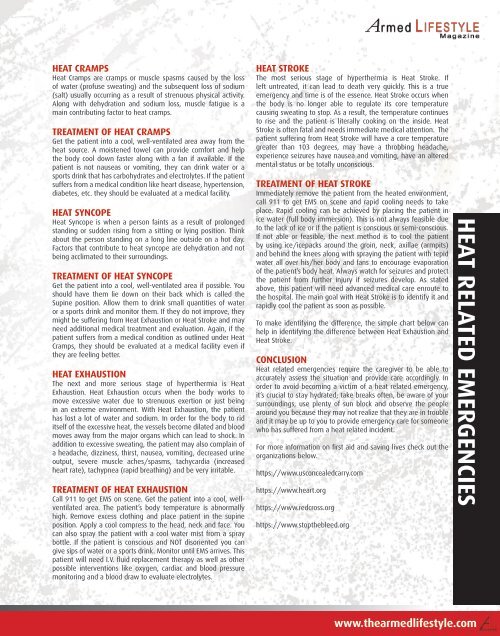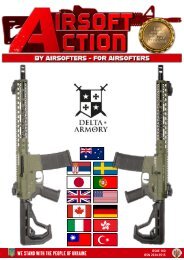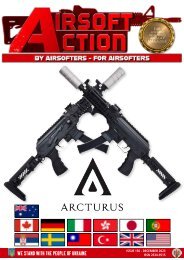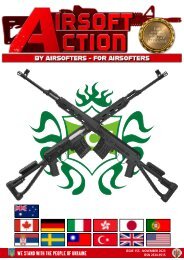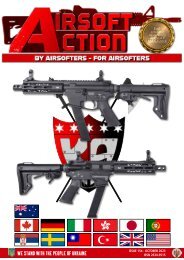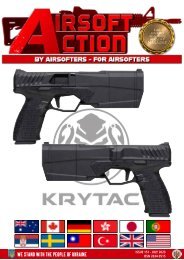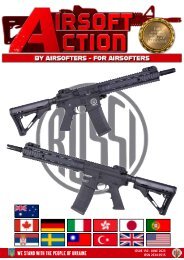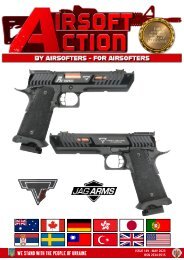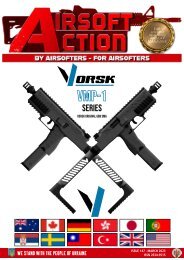Armed Lifestyle - Issue 2 - June 2022
Welcome to Issue 2 of The Armed Lifestyle! The AL team are REALLY getting into the groove to bring you, our fellow shooters, all the opinions and facts that we already know you love from your kind responses to Issue #1! We kick off this time with some awesome reviews by Trampas of the Ruger LCP MAX, a Less Than Lethal defense option from PepperBall, the Stoner-designed US Survival Rifle from Henry Repeating Arms, plus Jamie gets "hands on" with the TISAS 9mm. In addition, we've got our unique take on a super pack from Duluth in the form of "The Wanderer", a review of the LOKSAK Shieldsak and an in-depth look at the "Commander" folder from Emerson Knives! Jamie continues her look at "The New Shooter Perspective" and then Amy gets into discussing Realtor Safety and lands a super interview with one of the industry’s top instructors and founder of "Meet the Pressers", Klint Macro. Dan looks at the medical and psychological implications of working and shooting in hot weather, Charlie teams up with “Gun for Hire Radio” Host Anthony Colandro, Self Defense legend John Petrolino shares his thoughts on the Tactical Pen, and Rob again shares his vast knowledge as an internationally known firearms trainer to help readers decide how to choose the right course to fit their training needs! Then to wrap things up, Trampas gets into one of his favourite topics, that of "The Lost Art of Gunsmithing". So with even more gear reviews and articles to put you, the shooter who lives and breathes "The Armed Lifestyle" firmly in control, we hope that you'll dive on in and enjoy Issue 2!
Welcome to Issue 2 of The Armed Lifestyle! The AL team are REALLY getting into the groove to bring you, our fellow shooters, all the opinions and facts that we already know you love from your kind responses to Issue #1!
We kick off this time with some awesome reviews by Trampas of the Ruger LCP MAX, a Less Than Lethal defense option from PepperBall, the Stoner-designed US Survival Rifle from Henry Repeating Arms, plus Jamie gets "hands on" with the TISAS 9mm. In addition, we've got our unique take on a super pack from Duluth in the form of "The Wanderer", a review of the LOKSAK Shieldsak and an in-depth look at the "Commander" folder from Emerson Knives!
Jamie continues her look at "The New Shooter Perspective" and then Amy gets into discussing Realtor Safety and lands a super interview with one of the industry’s top instructors and founder of "Meet the Pressers", Klint Macro. Dan looks at the medical and psychological implications of working and shooting in hot weather, Charlie teams up with “Gun for Hire Radio” Host Anthony Colandro, Self Defense legend John Petrolino shares his thoughts on the Tactical Pen, and Rob again shares his vast knowledge as an internationally known firearms trainer to help readers decide how to choose the right course to fit their training needs!
Then to wrap things up, Trampas gets into one of his favourite topics, that of "The Lost Art of Gunsmithing".
So with even more gear reviews and articles to put you, the shooter who lives and breathes "The Armed Lifestyle" firmly in control, we hope that you'll dive on in and enjoy Issue 2!
Create successful ePaper yourself
Turn your PDF publications into a flip-book with our unique Google optimized e-Paper software.
HEAT CRAMPS<br />
Heat Cramps are cramps or muscle spasms caused by the loss<br />
of water (profuse sweating) and the subsequent loss of sodium<br />
(salt) usually occurring as a result of strenuous physical activity.<br />
Along with dehydration and sodium loss, muscle fatigue is a<br />
main contributing factor to heat cramps.<br />
TREATMENT OF HEAT CRAMPS<br />
Get the patient into a cool, well-ventilated area away from the<br />
heat source. A moistened towel can provide comfort and help<br />
the body cool down faster along with a fan if available. If the<br />
patient is not nauseas or vomiting, they can drink water or a<br />
sports drink that has carbohydrates and electrolytes. If the patient<br />
suffers from a medical condition like heart disease, hypertension,<br />
diabetes, etc. they should be evaluated at a medical facility.<br />
HEAT SYNCOPE<br />
Heat Syncope is when a person faints as a result of prolonged<br />
standing or sudden rising from a sitting or lying position. Think<br />
about the person standing on a long line outside on a hot day.<br />
Factors that contribute to heat syncope are dehydration and not<br />
being acclimated to their surroundings.<br />
TREATMENT OF HEAT SYNCOPE<br />
Get the patient into a cool, well-ventilated area if possible. You<br />
should have them lie down on their back which is called the<br />
Supine position. Allow them to drink small quantities of water<br />
or a sports drink and monitor them. If they do not improve, they<br />
might be suffering from Heat Exhaustion or Heat Stroke and may<br />
need additional medical treatment and evaluation. Again, if the<br />
patient suffers from a medical condition as outlined under Heat<br />
Cramps, they should be evaluated at a medical facility even if<br />
they are feeling better.<br />
HEAT EXHAUSTION<br />
The next and more serious stage of hyperthermia is Heat<br />
Exhaustion. Heat Exhaustion occurs when the body works to<br />
move excessive water due to strenuous exertion or just being<br />
in an extreme environment. With Heat Exhaustion, the patient<br />
has lost a lot of water and sodium. In order for the body to rid<br />
itself of the excessive heat, the vessels become dilated and blood<br />
moves away from the major organs which can lead to shock. In<br />
addition to excessive sweating, the patient may also complain of<br />
a headache, dizziness, thirst, nausea, vomiting, decreased urine<br />
output, severe muscle aches/spasms, tachycardia (increased<br />
heart rate), tachypnea (rapid breathing) and be very irritable.<br />
TREATMENT OF HEAT EXHAUSTION<br />
Call 911 to get EMS on scene. Get the patient into a cool, wellventilated<br />
area. The patient’s body temperature is abnormally<br />
high. Remove excess clothing and place patient in the supine<br />
position. Apply a cool compress to the head, neck and face. You<br />
can also spray the patient with a cool water mist from a spray<br />
bottle. If the patient is conscious and NOT disoriented you can<br />
give sips of water or a sports drink. Monitor until EMS arrives. This<br />
patient will need I.V. fluid replacement therapy as well as other<br />
possible interventions like oxygen, cardiac and blood pressure<br />
monitoring and a blood draw to evaluate electrolytes.<br />
HEAT STROKE<br />
The most serious stage of hyperthermia is Heat Stroke. If<br />
left untreated, it can lead to death very quickly. This is a true<br />
emergency and time is of the essence. Heat Stroke occurs when<br />
the body is no longer able to regulate its core temperature<br />
causing sweating to stop. As a result, the temperature continues<br />
to rise and the patient is literally cooking on the inside. Heat<br />
Stroke is often fatal and needs immediate medical attention. The<br />
patient suffering from Heat Stroke will have a core temperature<br />
greater than 103 degrees, may have a throbbing headache,<br />
experience seizures have nausea and vomiting, have an altered<br />
mental status or be totally unconscious.<br />
TREATMENT OF HEAT STROKE<br />
Immediately remove the patient from the heated environment,<br />
call 911 to get EMS on scene and rapid cooling needs to take<br />
place. Rapid cooling can be achieved by placing the patient in<br />
ice water (full body immersion). This is not always feasible due<br />
to the lack of ice or if the patient is conscious or semi-conscious.<br />
If not able or feasible, the next method is to cool the patient<br />
by using ice/icepacks around the groin, neck, axillae (armpits)<br />
and behind the knees along with spraying the patient with tepid<br />
water all over his/her body and fans to encourage evaporation<br />
of the patient’s body heat. Always watch for seizures and protect<br />
the patient from further injury if seizures develop. As stated<br />
above, this patient will need advanced medical care enroute to<br />
the hospital. The main goal with Heat Stroke is to identify it and<br />
rapidly cool the patient as soon as possible.<br />
To make identifying the difference, the simple chart below can<br />
help in identifying the difference between Heat Exhaustion and<br />
Heat Stroke.<br />
CONCLUSION<br />
Heat related emergencies require the caregiver to be able to<br />
accurately assess the situation and provide care accordingly. In<br />
order to avoid becoming a victim of a heat related emergency,<br />
it’s crucial to stay hydrated; take breaks often, be aware of your<br />
surroundings, use plenty of sun block and observe the people<br />
around you because they may not realize that they are in trouble<br />
and it may be up to you to provide emergency care for someone<br />
who has suffered from a heat related incident.<br />
For more information on first aid and saving lives check out the<br />
organizations below.<br />
https://www.usconcealedcarry.com<br />
https://www.heart.org<br />
https://www.redcross.org<br />
https://www.stopthebleed.org<br />
HEAT RELATED EMERGENCIES<br />
www.thearmedlifestyle.com


